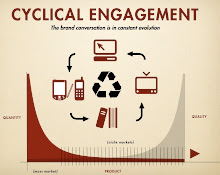So let's forget about technologies for a moment.
Let's look at the nature of content itself. There may be an important and delicate wrinkle within content development that may lead to leaving stronger and more indelible impressions on our mindshare. Let's also make this a more theoretical examination of where content development can go, something more expansive than mere (albeit innovative) case studies we've seen from the likes of Coke, Audi, BMW or EA.
First, let's redefine what content is. Wikipedia defines it as "information and experiences created for an audience". We can this step further and define it as: "anything that can be shared."
See, what we share with each other via of word of mouth is content, and arguably the most powerful form of it. The ethereal elements, the intangibles, are indelible and everlasting. The ideas we associate with them are the most shareable and scalable. Which is precisely why we must try not to confine them within ad or media units and inhibit their ability to scale.
Let's look at some hypotheticals.
Movies as user-generated mash-ups.
TV shows as multi-channel annotations.
Books as ongoing topical forums.
Periodicals as user-suggested news repositories.
Music channels as user-created set lists.
Clearly you see a common theme here: user-generation. While this is far from being a new concept, there is an element of reverse engineering at play here.
For one, the guesswork that goes into what content providers think what people want is somewhat buffered by merely giving them what they want. For another, once this content is reproduced and redelivered through a qualitative creative process, the new ideas that are generated start to proliferate. What evolves become phenomena.
All phenomena formalize as ideas that are exchanged and transformed through circumstance and lore.
So we can even ascribe a simple formula for 'good' content development:
CONCEPT (C) + ADOPTION (A) = PHENOMENON (P)
The concept represents the initial idea. Adoption materializes in the form of scalable ideation - people talking and developing new currency around the initial idea. The new ideas that are generated and owned and proliferated by people within their social graphs make this into a phenomenon.
The ultimate takeaway here is that we should probably look at content as something that takes on its own personality, and does so by virtue of what it represents in and of itself. Just as brands are owned by people, content also thrives on the construct of mindshare. The associations we make are potentially the stuff of legend.
Now back to the technologies that will facilitate this new movement... ;)







